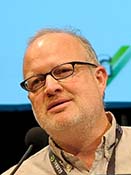Leadership takes many forms, but can anyone become a leader? A simple Webster definition of leadership is “a person that leads a party or a group,” but being a leader can mean so much more than that. A good leader can drive change and make hard decisions. An effective leader can inspire, motivate, and persuade.
“A true leader has the confidence to stand alone, the courage to make tough decisions, and the compassion to listen to the needs of others. He does not set out to be a leader, but becomes one by the quality of his actions and the integrity of his intent.” -Douglas MacArthur
I explored the question of what makes a great leader by interviewing two distinguished leaders in the electronic waste movement in Washington.
The United States generated about 7.1 Mt of electronic waste in 2014, according to the United Nations University. Electronic waste (e-waste) typically describes end-of-life products that use electricity, which are then disposed of improperly in a landfill or in some cases, exported to developing countries. E-waste contains hazardous materials that put both the environment and human health at risk.
As public awareness increases about the potential risk of improper e-waste management, there is a rapid shift to ban export, landfill disposal, and incineration of e-waste. At the same time, more organizations are shifting to increase recycling and reusing consumer electronics that are still functional. This push for awareness and change is initiated by people like Jim Puckett and Charles Brennick.
Who are they?

Source: estewards.org
Jim Puckett is the Executive Director and the co-founder of Basel Action Network (BAN) located in Seattle, Washington. BAN is a non-profit organization dedicated to ending the toxics trade by catalyzing market solutions and supporting integral policy strategies to promote environmental justice. A distinguished environmental activist, Jim spearheaded research on e-waste trade and was the first to expose the global issue while working for Greenpeace. He oversees the e-Stewards Certification Program, which certifies recyclers to a scrupulous environmental standard to differentiate honest recyclers from those that still participate in exportation of toxic wastes. Jim works with a team of seven individuals to provide vision, passion and direction for the organization.

Source: LinkedIn
Charles Brennick is the founder and Director of a non-profit organization – InterConnection – located in Seattle, Washington. He has a background in policy and business. He founded InterConnection in 1999 to refurbish and recycle consumer electronics and then provide these products to non-profits in all U.S. states and to communities around the globe. InterConnection’s mission is to provide technology access to underserved schools and communities, thereby closing the technology gap. InterConnection seeks to reuse products like unwanted computers and to channel those products to those in need responsibly and safely across the globe.
While Charles is on the side of reusing and recycling consumer electronics on the ground, Jim is on the policy and accountability side of things. Both are distinguished leaders who began non-profit organizations from the ground up with little financial stability and minimal staff, but a clear vision. Interestingly, they described similar skill sets when it came to explaining leadership.
What are some skills or characteristics of a great leader?
Some of the most important characteristics are:
Vision – This is the underpinning of core values and the mission of an organization. Charles explained that vision focuses where the organization is going and ensures continual growth and progression towards new horizons. This is a key ingredient for get others excited about the cause.
Mission – Communicates instead on how you get there, rather than where you are going. Jim emphasized that core values are integral and synonymous with mission because they frame the ethical context for the organization.
Passion – “If the heart is not there, people are not going to be drawn to you” – Jim Puckett
Motivation – It is important to both have self-motivation and the ability to motivate others. Effective leaders motivate others to want to help them rather than demand that they do so.
Confidence – Confident leaders trust their intuition. This enables them to make hard decisions or persevere.
Adaptability – Both Jim and Charles said that it is crucial to adapt to change: in mission, in the work place, or even in leadership. This gives the capacity for growth and sustainability in an organization.
Team Work – It’s not about one leader or one individual; it’s about the communities they serve. The keys to successful leadership are staying humble and working with others to achieve goals.
What are the biggest challenges leaders face today?
Despite maintaining the core skills in leadership, there are still many obstacles to overcome. Some

Source: http://www.ban.org/watchdog
challenges that leaders face are resistance, getting people involved, and financial barriers. To overcome resistance, Jim explains first that credibility and information is the most important. He, along with others, built up a strong informational base to establish expertise in the field of e-waste. BAN established an unwavering reputation for raising awareness about e-waste.
Over time, BAN became recognized as a reliable source. He emphasized that this took some time, so persistence and patience are crucial. Once people realize that you have the vigilance to remain strong even under pressure from other actors, you are able to demonstrate heart by not yielding on your vision. Combining these three tactics over time will resonate with other people and help the organization gain traction and support.
What are some of the most important decisions you make as a leader?
Charles pointed out that choosing his staff was one of the most important decisions he made as a leader. Your staff supports the organization’s goals and carries out initiatives, big or small, every day. It is important that the interests of the staff are aligned with the interest of the company as a whole. This is easily realized, says Jim, if you distinguish one clear idea for the organization and communicate this idea effectively.
What are you doing to ensure you continue to grow and develop as a leader?

Charles actively set out to be a leader. He maintains a strong work ethic, and receives outside help from coaches and leadership seminars to constantly grow as a leader. He mentions that it is important to adapt to change even if that means changing your mission. Charles’ mission originally began as an idea for a website, but grew into a non-profit that now reaches out to many national and international communities. He adds that remaining humble is key to development as a leader–humble in knowing you can always learn more, and humble in knowing that you will not always be the leader of your organization. Jim mentions that empowering others prepares the organization for the future and long term goals.
“Vision without execution is just hallucination” – Henry Ford
In short, good leadership requires a balance between emotional and logical traits. Many leaders find success through hard work, perseverance, and by adapting to change. Exceptional leaders are those who combine those traits with empathy, passion, and heart to motivate and inspire others.


Electronic Waste Management
Electronic waste management is a pressing global issue that demands immediate attention. The rapid proliferation of electronic devices, coupled with their short lifespans, poses significant environmental and health risks. By adopting a comprehensive approach that includes reducing, reusing, recycling, and implementing Extended Producer Responsibility, we can mitigate the e-waste crisis and work towards a more sustainable future. Public awareness, government regulation, and technological advancements will all play critical roles in addressing this growing challenge. As responsible global citizens, it is our duty to act now to safeguard our environment and well-being for generations to come.